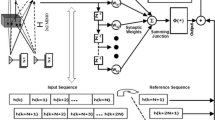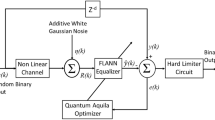Abstract
To mitigate the linear and nonlinear distortions in communication systems, two novel nonlinear adaptive equalizers are proposed on the basis of the neural finite impulse response (FIR) filter, decision feedback architecture and the characteristic of the Laguerre filter. They are neural FIR adaptive decision feedback equalizer (SNNDFE) and neural FIR adaptive Laguerre equalizer (LSNN). Of these two equalizers, the latter is simple and with characteristics of both infinite impulse response (IIR) and FIR filters; it can use shorter memory length to obtain better performance. As confirmed by theoretical analysis, the novel LSNN equalizer is stable (0 <a<1). Furthermore, simulation results show that the SNNDFE can get better equalized performance than SNN equalizer, while the latter exhibits better performance than others in terms of convergence speed, mean square error (MSE) and bit error rate (BER). Therefore, it can reduce the input dimension and eliminate linear and nonlinear interference effectively. In addition, it is very suitable for hardware implementation due to its simple structure.
Similar content being viewed by others
References
Proakis J G. Digital Communications. 4th ed. New York: McGraw-Hill, 2000
Haykin S. Adaptive Filter Theory. 4th ed. Englewood Cliffs, NJ: Prentice-Hall, 2001
Qureshi S. Adaptive equalization. Proc IEEE, 1985, 73(9): 1349–1387
Gibson G J, Sin S, Cowan C F N. Application of multilayer perceptions as adaptive equalizer. In: Proc of IEEE Int Conf on ASSP, Glasgow, Scotland, 1989. 1183–1186
Gibson G J, Sin S, Cowan C F N. The application of nonlinear structures to the reconstruction of binary signals. IEEE Trans Signal Process, 1991, 39(8): 1877–1885
Chen S, Gibson G. J, Cowan C F N, et al. Reconstruction of binary of signals using an adaptive radial-basis-function equalizer. Signal Process, 1991, 22(1): 77–93
Cha I, Kassam S A. Channel equalization using adaptive complex radial basis function networks. IEEE J Select Area Commun, 1995, 13(1): 122–131
Chen S, Mulgrew B, Grant P M. A clustering technique for digital communication channel equalization using radial basis function networks. IEEE Trans Neural Netw, 1993, 4(4): 570–579
Chen S, Mulgrrew B. Overcoming co-channel interference using an adaptive radial basis function equalizer. Signal Process, 1992, 28: 91–107
Kechriotis G, Zervas E, Manolakos E S. Using recurrent neural networks for adaptive communication channel equalization. IEEE Trans Neural Netw, 1994, 5(2): 267–278
Mandic D P. NNGD algorithm for neural adaptive filters. Electron Lett, 2000, 39(9): 845–846
Mandic D P, Hanna A I, Razaz M. A normalized gradient descent algorithm for nonlinear adaptive filters using gradient adaptive step size. IEEE Signal Process Lett, 2001, 8(11): 295–297
Hanna A I, Mandic D P. Nonlinear FIR adaptive filters with a gradient adaptive amplitude in the nonlinearity. IEEE Signal Process Lett, 2002, 9(8): 253–255
Mandic D P, Krcmar I R. Stability of NNGD algorithm for nonlinear system identification. Electron Lett, 2001, 37(3): 200–202
Wahlberg B. System identification using Laguerre models. IEEE Trans Autom Control, 1991, 36: 551–562
Makila P M. Approximation of stable systems by Laguerre filters. Automatica, 1990, 26: 333–345
Silva O T. On the determination of the optimal pole position of Laguerre filters. IEEE Trans Signal Process, 1995, 43(9): 2079–2087
Wang L, Cluett W R. Optimal choice of time-scaling factors for linear system approximations using Laguerre models. IEEE Trans Autom Control, 1994, 39(7): 1463–1467
Hung F Y, Zhang J S. A novel nonlinear adaptive prediction filter for narrowband interference suppression in DS-SS communication. J Electron Inf Tech, 2007, 29(6): 1328–1331
Author information
Authors and Affiliations
Corresponding author
Additional information
Supported partially by the National Natural Science Foundation of China (Grant No. 60971104), the Program for New Century Excellent Talents in University of China (Grant No. NCET-05-0794), and the Doctoral Innovation Fund of Southwest Jiaotong University
Rights and permissions
About this article
Cite this article
Zhao, H., Zhang, J. Neural FIR adaptive Laguerre equalizer with a gradient adaptive amplitude for nonlinear channel in communication systems. Sci. China Ser. F-Inf. Sci. 52, 1881–1890 (2009). https://doi.org/10.1007/s11432-009-0148-z
Received:
Accepted:
Published:
Issue Date:
DOI: https://doi.org/10.1007/s11432-009-0148-z




